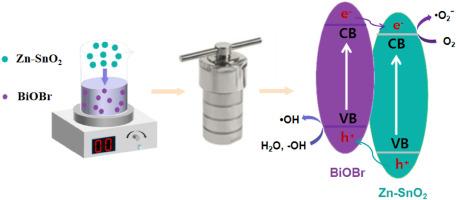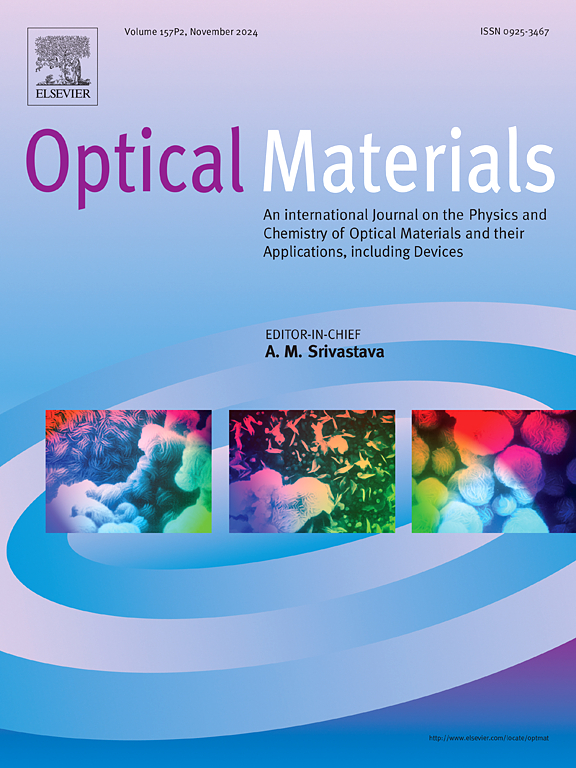构建具有双氧空位的 II 型 Zn-SnO2/BiOBr 异质结以增强光催化降解能力
IF 3.8
3区 材料科学
Q2 MATERIALS SCIENCE, MULTIDISCIPLINARY
引用次数: 0
摘要
采用一步水热法成功合成了用于光催化降解染料的新型异质结材料 Zn-SnO2/BiOBr。异质结的形成增强了空位耦合效应。光催化实验结果表明,0.3Zn-SnO2/BiOBr(当 Zn-SnO2 与 BiOBr 的摩尔比为 0.3 时形成的异质结)在 15 分钟内对罗丹明 B(RhB)的降解率分别是 BiOBr 和 Zn-SnO2 的 9.27 倍和 476.9 倍。此外,0.3Zn-SnO2/BiOBr 对碱性品红(BF)的降解率分别是 BiOBr 和 Zn-SnO2 的 4.2 倍和 21.9 倍。Zn-SnO2/BiOBr光催化性能的明显改善是由于Zn-SnO2/BiOBr中的许多氧空位与II型异质结协同作用,有效地促进了窄带隙值,增加了光生电子(e-)和空穴(h+),提高了可见光下的电荷分离效率,有利于染料的光催化降解。本文章由计算机程序翻译,如有差异,请以英文原文为准。

Construction of Type-II Zn–SnO2/BiOBr heterojunctions with Dual-oxygen vacancies for enhanced photocatalytic degradation
Zn–SnO2/BiOBr, a novel heterojunction material for photocatalytic dye degradation, was synthesized successfully using the one-step hydrothermal method. The formation of the heterojunction enhanced the vacancy coupling effect. The photocatalytic experiment results showed that the degradation rate of Rhodamine B (RhB) due to 0.3Zn–SnO2/BiOBr (the heterojunction formed when the molar ratio of Zn–SnO2 to BiOBr was 0.3) within 15 min was 9.27 and 476.9 times that of BiOBr and Zn–SnO2, respectively. Additionally, the degradation rate of basic fuchsin (BF) due to 0.3Zn–SnO2/BiOBr was 4.2 and 21.9 times that of BiOBr and Zn–SnO2, respectively. The significantly improved photocatalytic performance was because many oxygen vacancies in Zn–SnO2/BiOBr collaborated with the type-II heterojunction to promote a narrow bandgap value efficiently, increasing the photogenerated electrons (e–) and hole (h+), an increased charge separation efficiency under visible light, and favored the photocatalytic degradation of dyes.
求助全文
通过发布文献求助,成功后即可免费获取论文全文。
去求助
来源期刊

Optical Materials
工程技术-材料科学:综合
CiteScore
6.60
自引率
12.80%
发文量
1265
审稿时长
38 days
期刊介绍:
Optical Materials has an open access mirror journal Optical Materials: X, sharing the same aims and scope, editorial team, submission system and rigorous peer review.
The purpose of Optical Materials is to provide a means of communication and technology transfer between researchers who are interested in materials for potential device applications. The journal publishes original papers and review articles on the design, synthesis, characterisation and applications of optical materials.
OPTICAL MATERIALS focuses on:
• Optical Properties of Material Systems;
• The Materials Aspects of Optical Phenomena;
• The Materials Aspects of Devices and Applications.
Authors can submit separate research elements describing their data to Data in Brief and methods to Methods X.
 求助内容:
求助内容: 应助结果提醒方式:
应助结果提醒方式:


